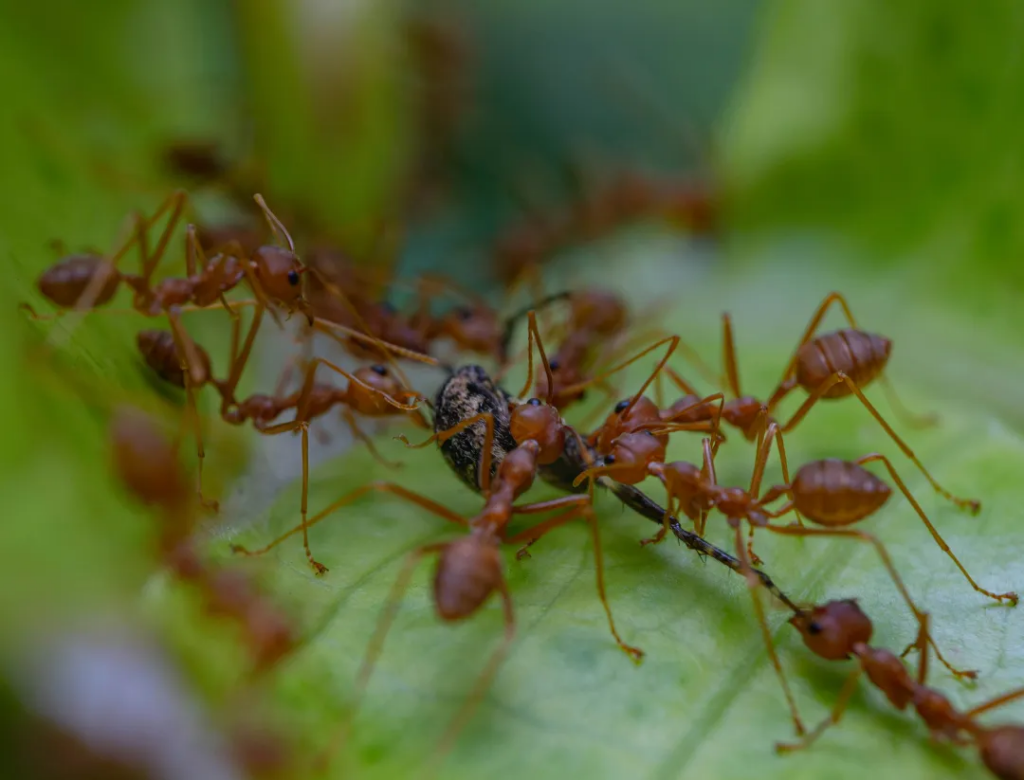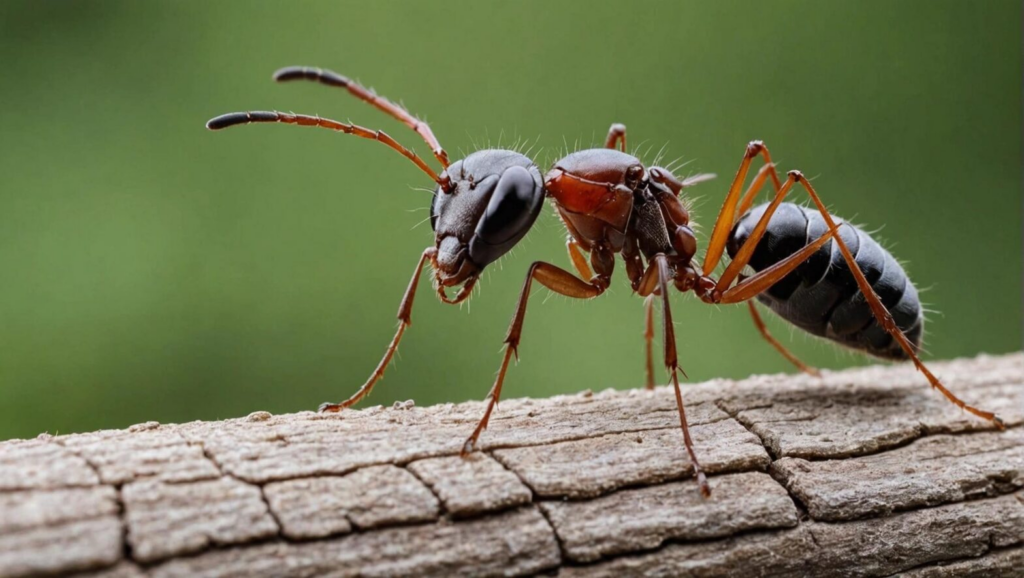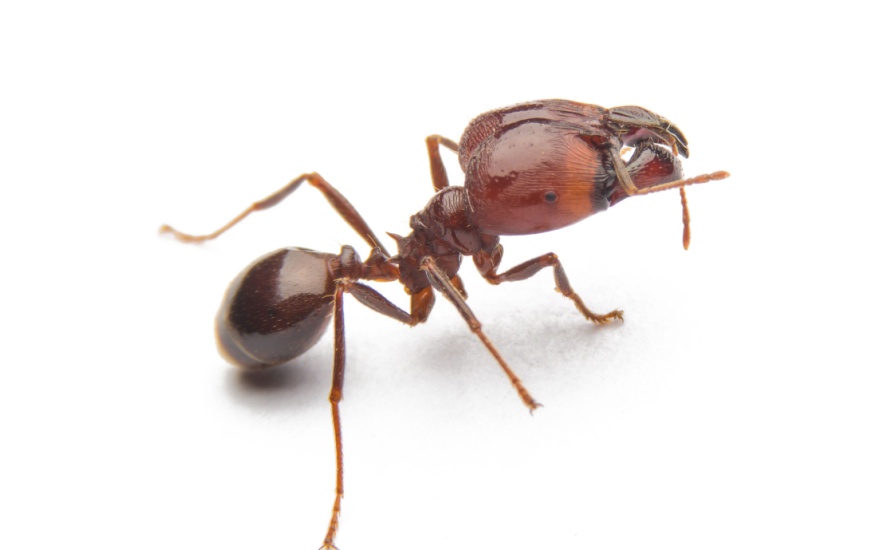Dallas, TX, has many ant species. Over 290 have been found here. At Vinx Pest Control, we know how to spot the different ants that bother homes and businesses.
Some common ants in Dallas are fire ants, carpenter ants, and Pharaoh ants. Fire ants sting painfully. Carpenter ants can damage wood. To find out more about Dallas’s ants, check our page on the different kinds of ants in Dallas.
Key Takeaways
- Over 290 ant species are found in the Dallas Metropolitan area.
- Common ant species include fire ants, carpenter ants, and Pharaoh ants.
- Different ant species exhibit unique behaviors and characteristics.
- Understanding ant species is key to controlling ant infestations.
- Vinx Pest Control offers expert solutions for ant problems.
Common Ant Species in Dallas, TX
Knowing the types of ants in Dallas, TX, is key for good pest control. The area has many ants that are common and can harm homes and properties.
Fire Ants
Fire ants are very common in Dallas. They sting painfully and can cause allergic reactions. These ants are reddish-brown and build big mounds in lawns and gardens.
Fire ants live in big groups with a complex social structure. Their stings can be a big problem, making them a worry for homeowners, mostly when they’re outside.

Carpenter Ants
Carpenter ants are big and can damage wood. They don’t eat wood but make nests in it, which can weaken buildings.
These ants are black or dark brown and live in many places, including trees and homes. They like moist wood, so areas with a lot of humidity or water damage are more likely to get infested.

Pharaoh Ants
Pharaoh ants are small and light yellow to reddish-brown. They can spread diseases and are a big worry in homes, hospitals, and buildings. They can contaminate food and surfaces.
Pharaoh ants can live in many places and form big colonies. They are hard to get rid of because they can nest in small, hard-to-reach spots.

Crazy Ants
Crazy ants are fast-moving and named for their crazy behavior. They are a newer problem in Texas. They form big colonies and can invade homes, mostly when it’s hot or dry.
Crazy ants are dark brown or black and like electrical devices. They can cause problems with sensitive electronics in homes.
In summary, knowing about these common ants in Dallas, TX, is important for controlling them. By spotting infestations early and taking action, homeowners can avoid ant problems.

Understanding Ants: Biology and Behavior
Exploring the world of ants shows us complex societies. These societies have different roles and hierarchies. This helps us understand how ants take over homes.
Ant Colony Structure
An ant colony is very organized. It has different castes, each with its own job. The queen ant leads the colony and lays eggs.
The colony’s social hierarchy includes:
- Workers: These ants find food, care for young, and keep the colony clean.
- Soldiers: Bigger and stronger, soldiers protect the colony from danger.
- Queens: Queens are the reproductive females. They lay eggs and keep the colony alive.
Reproduction Cycles
Ants have complex ways of reproducing. Knowing these cycles helps us manage ants better.
Important parts of ant reproduction are:
- Nuptial flights, where new queens and males mate.
- New colonies start when fertilized queens find a new place to live.
- Pheromones help control when ants reproduce.
Feeding Habits
Ants eat many things, like sweets, proteins, and oils. Their eating habits help them take over homes.
Some foods that attract ants include:
- Sugar and sweet things.
- Proteins like meats and pet food.
- Grease and oils.
Identifying Ants in Your Dallas Home
To manage ants, first identify them. Look at their physical traits and how they act. Knowing the ant type helps control pests better.
Physical Characteristics
Ants have unique features. Notice their size, color, and body shape. These details help identify them.
Size and Color Variations
Ant sizes and colors differ. Fire ants are reddish-brown and small to medium.
- Fire ants: 1/16 to 1/4 inch, reddish-brown
- Carpenter ants: 1/4 to 1/2 inch, black or dark brown
- Pharaoh ants: 1/16 inch, yellow or light brown
Body Structure
Ants have a narrow waist and bent antennae. These features help identify them.
- Narrow waist between the abdomen and thorax
- Elbowed antennae
- Distinct segmentation of the body
Behavior Patterns
Ant behavior is key to identification. Each species has its own foraging and social patterns.
- Foraging behavior: Some ants like sweet foods, others protein.
- Social structure: Watching how ants interact helps identify them.
Nesting Locations
Ants nest in certain spots in and around homes. Finding these spots helps identify the ant type.
- Moist areas: Near kitchens, bathrooms, or humid spots.
- Food sources: Near where food is stored or made.
- Hidden areas: Behind walls, under floors, or in quiet corners.
Seasonal Ant Activity in North Texas
As the seasons change in North Texas, ant activity changes a lot. Knowing these changes helps us manage ants better.
Spring and Summer Infestations
In spring and summer, ants are more active. This is because it’s warmer and more humid. These conditions help ants find food and grow their colonies.
- Ants are more active, foraging for food and resources.
- Colony growth accelerates as new workers emerge.
- Nesting sites become more apparent as ants venture indoors.
Fall and Winter Ant Behavior
In fall and winter, ants are less active because it’s colder. But, some ants might stay inside looking for food and shelter.
- Some ant species, like odorous house ants, invade homes in search of warmth.
- Food storage areas become vulnerable to ant infestations.
- Sealing entry points becomes critical to prevent indoor nesting.
Why Ants Invade Dallas Properties
Ants in Dallas homes and businesses come from a few main reasons. They are smart and can adapt easily. They look for important things to survive.
Food Sources That Attract Ants
Ants like many foods, like sweets, proteins, and fats. Things that attract them include:
- Crumbs and spills
- Unsealed food containers
- Pet food left outdoors
To stop ants, keep your home clean. Store food in sealed containers. Clean counters and sweep floors often to get rid of crumbs and spills.
Water Attractions in Your Home
Ants need water to live. Homes with moisture problems attract them. Common places include:
- Leaky pipes and faucets
- Clogged drains
- High humidity areas, such as basements or crawl spaces
Fixing leaks and lowering humidity makes your home less appealing to ants. Using a dehumidifier in damp places helps a lot.
Shelter and Nesting Opportunities
Ants also look for places to live and nest. Things that help them include:
- Cluttered areas, such as storage rooms or attics
- Unsealed entry points, like cracks in walls or foundations
- Nesting sites near food and water sources
Sealing entry points and keeping your home tidy stops ants from nesting. Check your home for ants often. Fix any problems quickly to stop infestations.
Health and Property Risks of Ant Infestations
Ant infestations can harm your health and property. It’s important to know the dangers. Ants might seem like just a problem, but they can cause big issues if not stopped.
Disease Transmission Concerns
Ants can spread diseases. Some ants, like Pharaoh ants, carry harmful germs. They can make food, surfaces, and medical tools dirty, which is risky, mainly in hospitals.
Pharaoh ants can spread Staphylococcus and Salmonella bacteria. Keeping your place ant-free is key to avoiding disease. If you have ants, act fast to stop the risk.
Structural Damage from Carpenter Ants
Carpenter ants can damage your home. They don’t eat wood but dig into it to make nests. This can make your house weak and cost a lot to fix.
A big carpenter ant problem can make wooden parts of your house weak. If you think you have carpenter ants, get help fast. Look for Allen ant control experts.
Food Contamination Issues
Ants like food and can make it dirty. When they get into your kitchen, they can touch food and leave germs behind.
This can make you sick. Keep your kitchen clean and food sealed. Clean up spills and make sure your kitchen is dry to keep ants away.
DIY Ant Prevention and Control Methods
To keep ants away, simple DIY methods work well. Homeowners in Dallas, TX, can use these to fight off ants.
Essential Sanitation Practices
Keeping your home clean is key to fighting ants. This means:
- Regularly sweeping and vacuuming floors, where food is made or eaten.
- Wiping down surfaces with soap and water to clean spills and crumbs.
- Storing food in sealed containers and cleaning up crumbs and spills fast.
By keeping your home clean, you make it less appealing to ants.

Sealing Entry Points and Cracks
Ants can sneak in through tiny openings. To stop this:
- Check your home’s outside and seal gaps around windows, doors, and pipes.
- Use caulk or weatherstripping to block cracks and crevices.
- Focus on areas around utility lines and vents.
Sealing these spots can cut down on ant visits.
Natural Ant Repellents
Looking for safe ways to keep ants away? Natural repellents are good. Some options are:
- Cinnamon: Sprinkle cinnamon where ants are seen and around entry points.
- Vinegar: Mix equal parts water and vinegar in a spray bottle to keep ants away.
- Essential Oils: Certain oils, like tea tree oil and lavender oil, can keep ants off when used right.
These natural repellents can help in your fight against ants.
Over-the-Counter Treatment Options
When DIY methods don’t work, OTC treatments can help. These include:
- Baiting systems with slow-acting poison, letting ants carry it back to their queen.
- Sprays and gels for direct use on ant trails and nests.
It’s important to follow the product’s instructions to use it safely and effectively.
Professional Ant Extermination Techniques
Professional ant extermination is often the best way to get rid of ants. Our pest control service uses many methods to make sure ants are gone for good.
Integrated Pest Management Approaches
We use Integrated Pest Management (IPM) for ant extermination. This method looks at the whole property ecosystem. IPM includes:
- Inspecting the property to find ant species and their homes
- Checking how bad the ant problem is
- Creating a special treatment plan
- Using different treatments like baiting and barriers
Targeted Baiting Systems
Targeted baiting systems are great for killing ant colonies. This method involves:
- Finding out which ant species are there and where they go
- Putting out baits that ants find tasty
- Watching how ants take the bait and changing the plan if needed
Barrier Treatments
Barrier treatments are used to keep ants out. We apply a special treatment around the property’s edges. This is often done with baiting too.
Barrier treatments have many benefits. They include:
- Long-lasting protection against ants
- Stopping ants from getting in
- Less chance of ants damaging your property
When to Call Vinx Pest Control for Ant Problems
When ants take over your home, it’s time to call for help. Vinx Pest Control is here to save the day. They have the skills and tools to tackle tough ant problems.
Signs of Severe Infestation
Big ant problems show up when ants are everywhere, near food. You might also see:
- Ant nests or mounds in your yard or walls.
- Damage from ants, like carpenter ants harming your home.
- Ants keep coming back, even after you try to stop them.
Seeing these signs means you need to act fast. This stops more damage and keeps you safe from ant health risks.
Benefits of Professional Treatment
Getting help from Vinx Pest Control is smart. They know how to get rid of ants for good. They find and fix the main problem, so ants don’t come back.
Professional help offers many perks, like:
- They know which ants you have and where they live.
- They make a special plan just for your ant problem.
- They use the latest ant-fighting tools and tricks.
Our Complete Ant Control Process
At Vinx Pest Control, we start with a detailed check of your home. We find out how bad the ant problem is and who they are. Then, we create a plan to get rid of them for good.
Our plan might include baiting, barrier treatments, and more. We aim to not just solve the problem but also teach you how to keep ants away. Choosing Vinx Pest Control means you’re on your way to a home free from ants.
Conclusion
Learning about ants is key to controlling them in Dallas, TX. We talked about common ants like Argentine Ants, Odorous House Ants, and Fire Ants. Each has its own ways of living and acting. To stop ants, knowing how they work is very important.
Understanding ants helps us keep our homes safe. We can stop ants by keeping our homes clean and sealing holes. If ants are a big problem, getting help from experts like Vinx Pest Control is a good idea.
For more info, check out this link.
FAQ
Q: What are the most common ant species found in Dallas, TX?
A: In Dallas, TX, you’ll find Fire Ants, Carpenter Ants, Pharaoh Ants, and Crazy Ants. Knowing about these ants helps us fight them better.
Q: How can I identify ants in my Dallas home?
A: Look at the ants’ size, color, and shape to identify them. Watch how they move and where they nest. They like food and water.
Q: Why do ants invade properties in Dallas, TX?
A: Ants look for food, water, and a place to live. They’re drawn to sweet things, moisture, and cozy spots.
Q: What are the health risks of ant infestations?
A: Ants can spread diseases and make food unsafe. Some ants sting painfully. Others carry germs.
Q: How can I prevent ant infestations in my home?
A: Keep your home clean and seal up holes. Don’t let water sit. Natural repellents and store-bought treatments can also help.
Q: When should I call a professional for ant control?
A: Call a pro if you see lots of ants or ants in your food. Experts use special methods to get rid of ants for good.
Q: What are the benefits of professional ant extermination?
A: Pros can get rid of ants for good. They find and fix problems like moisture. This keeps ants away for a long time.
Q: How do seasonal changes affect ant activity in North Texas?
A: Ants are busier in spring and summer. In fall and winter, they might come inside. Keep your home clean and sealed.
Q: Can I use natural ant repellents to control ants?
A: Yes, things like cinnamon and vinegar can keep ants away. But for big problems, you might need a pro.
Q: What is the importance of understanding ant biology and behavior?
A: Knowing how ants live and work helps us fight them better. We can then make plans to get rid of them for good.



